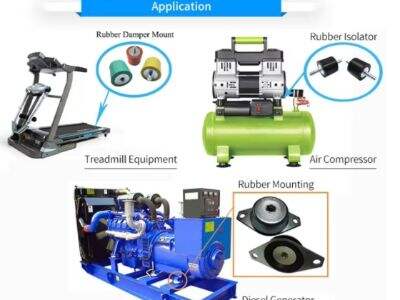Rubber buffers are little bits of rubber used to soften a lot of areas. They can be sandwiched between two things to prevent loud noises from occurring. The collision of two objects can produce a loud sound, which can be quite annoying. But when you should use rubber buffers, they reduce the impact, so the sound is much quieter. This can be incredibly useful in many areas, school, house, playground, etc. Loud sounds are annoying, where rubber buffers use to make it easier by reducing the noise.
Rubber Buffers of Multiple Types
You can find many different types of rubber buffers, which can be used for noise reduction in various situations. Rubber buffers are soft rubber or hard rubber. Each of them is used for different reasons. Soft rubber buffers do a great job of damping vibrations, which can reduce the banging and clattering that comes from moving parts. Hard rubber buffers, on the other hand, are more effective at deadening loud impact noises. They can soak up the impact of things slamming into each other. One type of rubber buffer may be more or less effective depending upon where it is used and how. Getting a rubber buffer is crucial, but so is getting the right kind of rubber buffer to maximize effectiveness.
Using Rubber Buffers to Reduce Noise
All-tok squeak noise is something rubber, and rubber buffers are a little more noise level. For instance, you are able to place rubber buffers below the legs of furnishings similar to chairs and tables so that they make much less noise when they’re moved. This is a great feature when you are in a classroom or at home where there could be a lot of movement. Because rubber buffers are commonly used in machines, they are also used in factories or workshops. They reduce the noise of moving parts, helping to create a quieter working environment. When strategically placed in the right spots, noise reduction can drop, creating a peaceful place for everyone.
Differentiate Between Rubber Buffers and Other Solutions
Rubber buffers really work for quietening things down, but there are other options too. Carpets and rugs, for instance, can be quite effective because they absorb sound in a room. Sound waves that bounce against the soft surface of a carpet or rug are absorbed, reducing the level of noise in the room. And special soundproofing materials can be added to walls to help, too. It's commonly utilized in areas such as recording studios or quiet spaces. Yet rubber buffers are usually an easier and more economical noise mitigation solution in many circumstances. They are very simple to use and can be a great first step toward a quieter space.
Tips for Using Rubber Buffers
When you want the best from your rubber buffers, you need to choose the right type for the job in hand. Soft rubber buffers are great at absorbing vibrations while hard rubber buffers are better for absorbing higher intensity sounds when things strike each other. In addition, this will function even better if rubber buffers are placed where the sound is at its loudest. If it’s a lot of noise from a slamming door, for instance, putting a rubber buffer on the door frame will help reduce that sound. Follow the above-mentioned tips to use rubber buffers to achieve a quieter space as a comfortable environment for all.
So, rubber buffers are convenient for noise prevention in various areas. THE TAKEAWAY: By knowing how they function, learning which types are available, using them properly in various situations, comparing them to other noise-reduction techniques, and following steps to maximize their effectiveness, you can successfully help quiet your environment. Next time, when you require a more peaceful environment, consider obtaining some rubber buffers for improved soundproofing.

